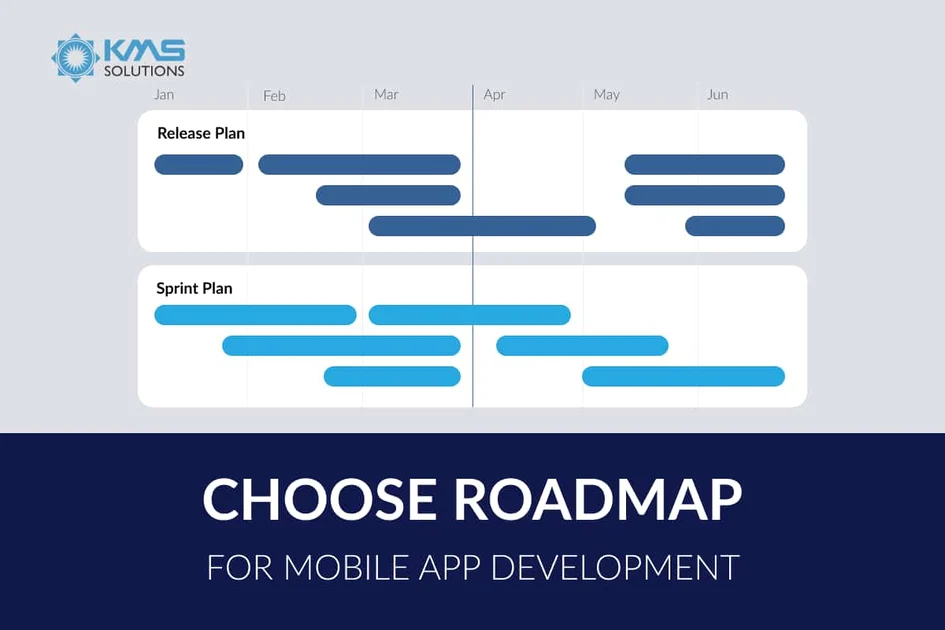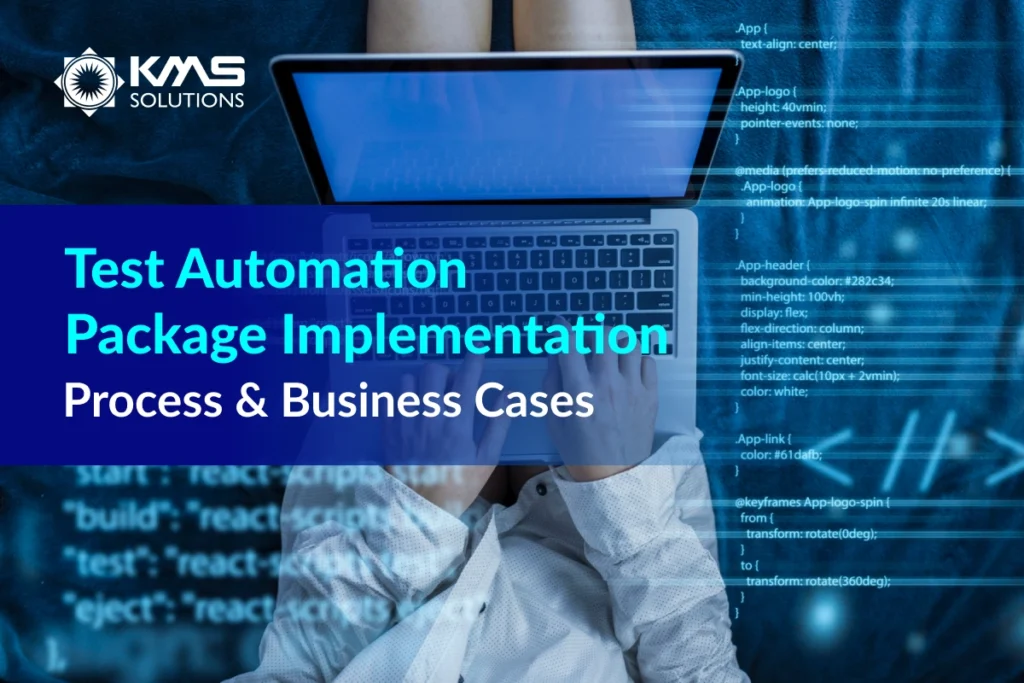Every day, the project manager may have to face tons of questions regarding the software development process, such as “What are we going to do next?” or “What’s the actual plan?”. One of the possible ways to get ahead is creating a mobile banking app that communicates the development plan and aligns your whole organization around it.
A roadmap is beyond a to-do list of forthcoming activities. A practical roadmap for mobile app development can capture your high-level product direction, define the tasks required to reach your objectives, and ultimately boosts confidence in your product leadership. However, some corporations fail to build an effective mobile app development roadmap since they concentrate excessively on meeting deadlines above all else, which may cause significant anxiety for the team.
In fact, there are lots of things that you will need to consider when creating a roadmap for mobile app development. Let’s see what they are and which types of the product roadmap that work best for your specific app development.
Essential Elements of the Mobile Development Roadmap
As the roadmap plays a crucial role in the mobile app development strategy, it should be accurate, actionable, and visually appealing. Moreover, it can also be considered as a project plan, with tasks distributed over sprints or months based on a team’s projected velocity. Therefore, the mobile roadmap should include:
1. Measurable Goals
An objective lets your company expect what can be achieved after completing the execution stage. These can be product-specific goals or business goals. However, it’s necessary to ensure that your objectives are clear and viable to team members. The goals that you set should be as follows:
- Increase monthly active users by 10%
- Launch the second version of the mobile app with better UI
- Add three new features
2. Timeline
A single roadmap for app development contains multiple timelines stacked within. Having timelines in your mobile app development roadmap is essential as it helps you visualize and prioritize tasks to be done, communicate release dates and get consensus on product direction.
It’s not necessary to list particular dates on your roadmap; however, you still need to clearly identify the milestones when a certain version of the mobile app is completed or move to the next phase of the development process. Examples of timelines include:
- Q1, Q2, Q3
- October, November, December
- Now, Next, Later
3. Features
Which features are you releasing along the timeline above? You can categorize the features based on their significance and what tools you use for project management. When developing a mobile app, you can consider creating a hierarchy of broad feature themes down to more specific subfeatures. Example of features (from high level to detailed):
Mobile banking app: Account management dashboard, Account balance, History record, Card management. Check out the innovative features of the mobile banking app here!
Team management app: New user onboarding, Team collaboration, Video messaging.
Effective Roadmaps for Mobile App Development
Having worked with many multinational corporations for building mobile apps, we notice that there are some common categories of roadmaps that are worth considering for the engineering team. At a high level, you can differentiate between two overall types of roadmaps for app development: column and timeline, with relevant roadmap examples defined.
1. Release plan roadmap
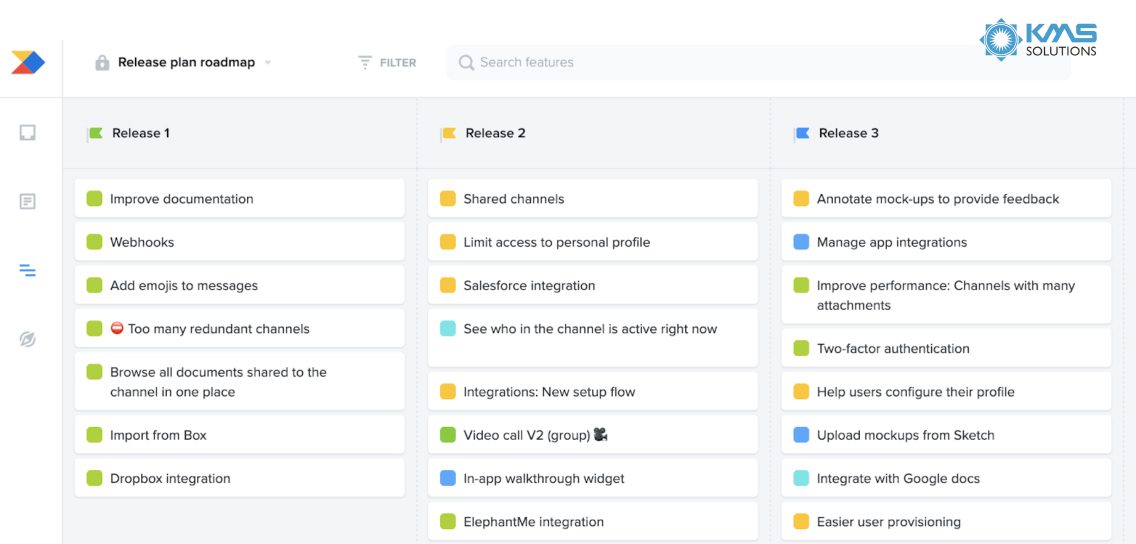
A release plan is an execution-level plan outlining how and when you intend to deliver the work you’ve prioritized, including new improvements, features, and bug fixes that will be launched in your upcoming release cycles. It can be utilized to provide senior executives, stakeholders, and cross-functional teams with a high-level overview of the planned product releases.
It’s ideal for establishing milestones that aren’t time-bound but have a defined scope or new versions of your mobile app on a regular release schedule. It informs other teams that new features will be launched, making it easier to coordinate the work between different company departments.
2. Sprint plan roadmap
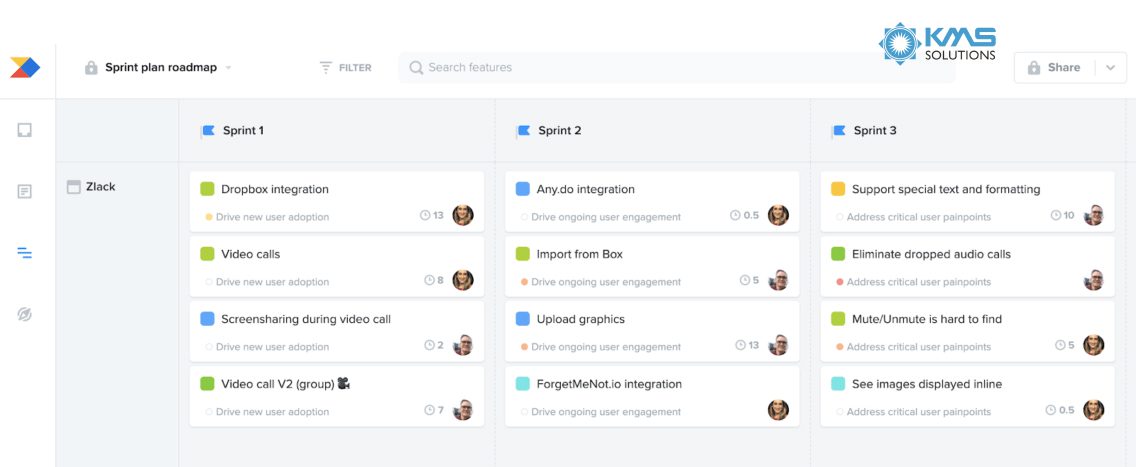
Projects will run more efficiently and with less friction when the team is informed of what is occurring. Here is where the sprint plan roadmaps come in, as they emphasize product deliverables. This is the greatest way to keep your development team and delivery team aligned, ensuring everything is up-to-date and on track.
You can manage your team’s workload by planning your delivery over multiple sprints and assigning the responsible person and the effort required for each feature. Sprints might range from a single week to a longer period of time; therefore, a sprint roadmap utilizes the provided timeframe and plans it all out for optimal success.
Sprint plan roadmap can be displayed as granular levels or swimlanes for additional context or grouping.
3. Kanban roadmap
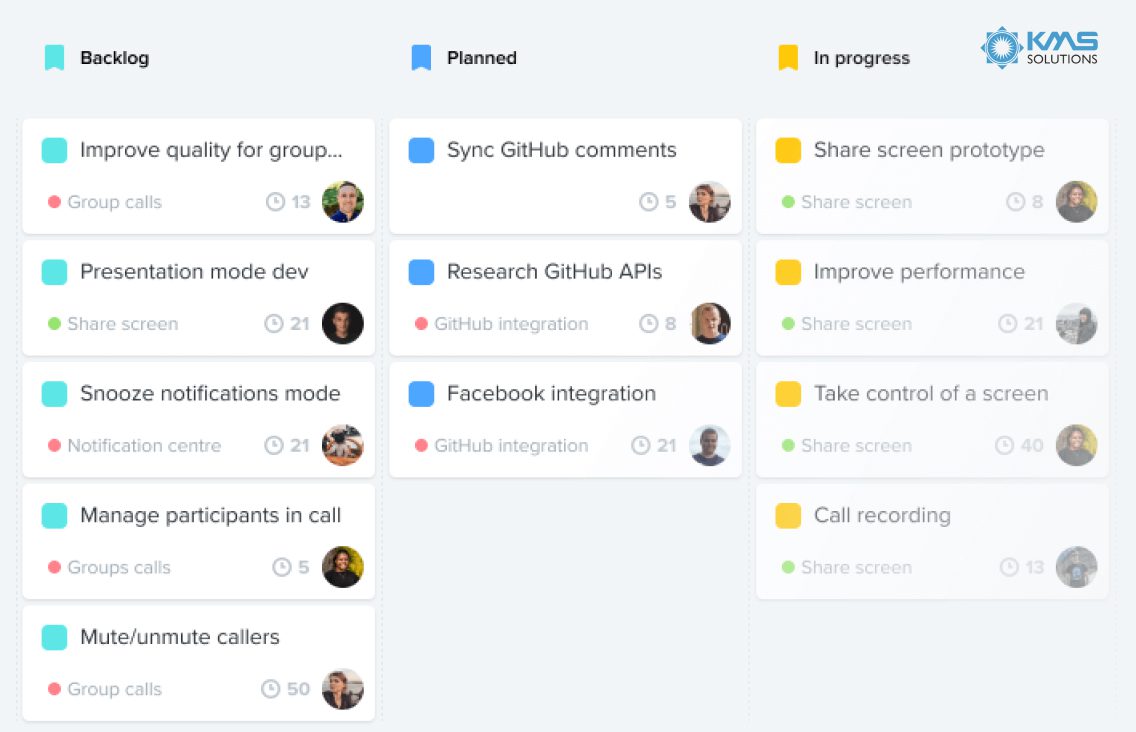
This is another delivery-focused roadmap for development teams that help them group initiatives into buckets. You can check what is in the backlog, what you’re planning, what is in progress, and what you’ve completed.
Kanban is the most effective way to build a feature prioritization process. One of the best benefits of this roadmap is that it allows the teams to merge both a strategic roadmap and backlog items —and to use clear visual buckets to differentiate the two. For mobile app development plans that are frequently changed in direction, you can consider implementing the Kanban roadmap to avoid the pitfall of committing to an inflexible, yearlong roadmap.
4. Feature timeline roadmap

This kind of mobile app roadmap is an output-driven roadmap that lets you determine the timing for a single feature. Planning features and tracking progress with a timeline roadmap is ideal if you demand an overview of how work is proceeding toward a deadline or time-bound milestone.
Sometimes, one feature needs to be done before moving on to another, requiring you to ensure the feature progress is on track with specified deadlines and milestones. For instance, when building a banking app, you’ll need to complete the Transaction and Payment feature before moving to QR code payment or Advance P2P payment.
With this roadmap, you may track feature development against particular deadlines and milestones, as well as coordinate with internal development teams on exact dates. Additionally, you may allocate resources when and where they are required.
5. Objective timeline roadmap
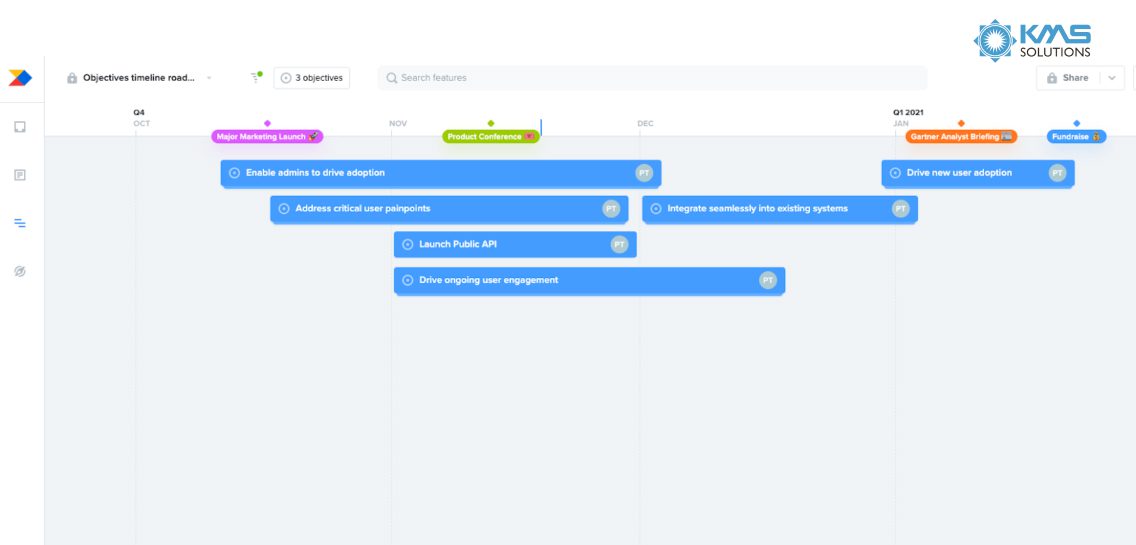
For large corporations and those working in more complicated environments, using an objective timeline roadmap will help communicate product strategy and objectives across teams for the next 2-3 quarters. When using business-level objectives, this allows a clear connection between your mobile app strategies and end deliverables, such as features.
This objective roadmap provides a big picture and ensures that the entire business is on the same page regarding the strategy.
6. Release timeline roadmap
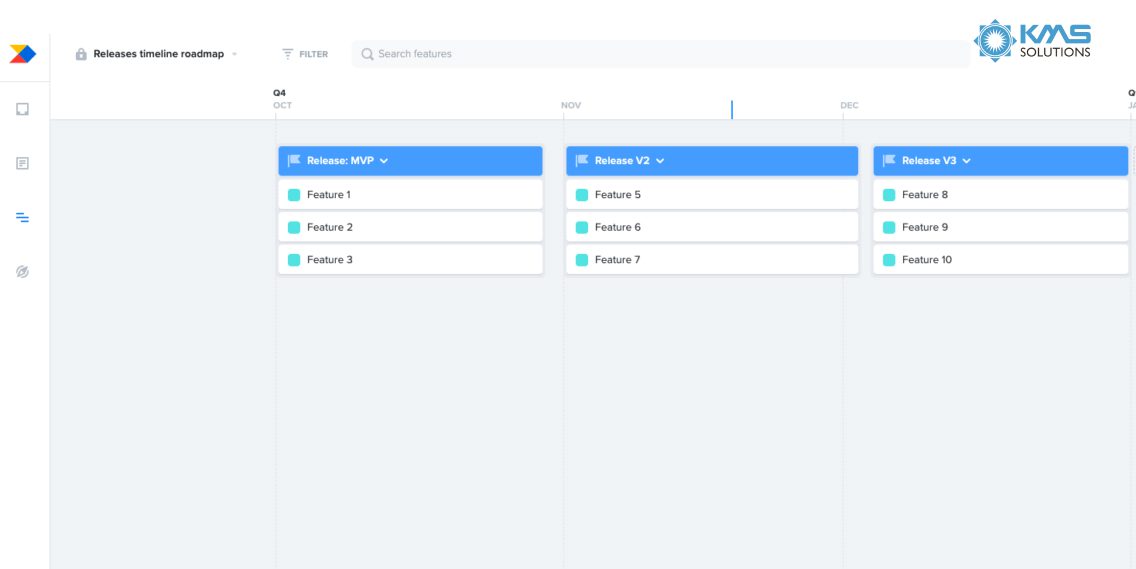
When working on releases with specified deadlines, a release timeline roadmap allows you to plan and communicate to cross-functional teams such as sales and customer success. Stakeholders can see upcoming app versions, quarterly releases, monthly bug fixes, and so on.
Large businesses with numerous teams releasing features on different cadences can use release timeline roadmaps to keep cross-functional teams informed.
In addition, you may build a low-maintenance tactical roadmap based on release schedule roadmaps to monitor your progress against critical milestones. However, in Agile development, it can be challenging to plan releases further than 4-6 weeks in advance. A release timeline roadmap enables you to continue utilizing your own release objects while expressing a time horizon with any crucial milestones or business deadlines.
Key Considerations when Creating an Effective Roadmap for Mobile App
Prior to drafting the mobile app development roadmap and beginning to visualize all the data you have, here are things you should keep in mind:
- Who are you building the mobile app development roadmap for?
The stakeholders of the roadmap determine the type of roadmap, its contents, and details. The roadmap audience can be internal – the teams directly participate in the development process, for instance, or external – the roadmap may be created for individuals who aren’t involved in the app development.
- What are the main features of the mobile app and their exact functionality?
When creating a feature list for the mobile app development roadmap, emphasizing the role of prioritization is necessary. Define the resources required to create each feature and set deadlines that correspond to the tentative launch date. Moreover, it’s vital to note that feature descriptions should be precise enough to provide development teams with the information they require to build the optimal solution.
- Which set of metrics to evaluate progress?
To ensure your mobile app development roadmap is effective, you should establish KPIs for all teams involved. It’s worth considering making a comprehensive list of all features you want to include and linking them with proper metrics to gauge progress.
- Keeping the information in the roadmap up-to-date
Since the mobile app development roadmap can reflect the development progress, you should keep it dynamic. This is critical for sharing information with all the teams working on a product.
Bottom Line
Every product needs a plan, and every plan needs a roadmap. Thus, having the right type of roadmap before building a mobile app is integral for a successful project.
At KMS Solutions, building an effective software roadmap is an essential part of the app development projects, which means we always conduct preparatory work to ensure alignment with the client’s product objectives and strategy, desired format, category of the roadmap, and demanded timeframes.



